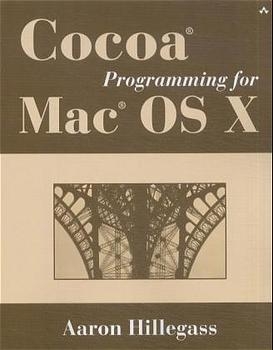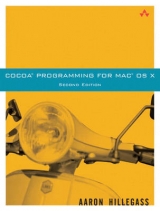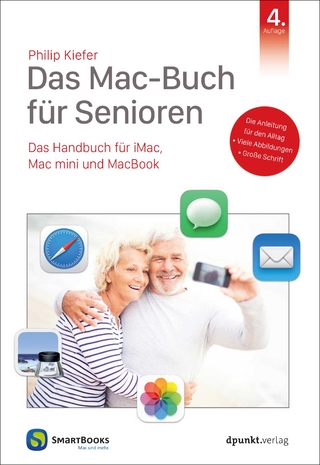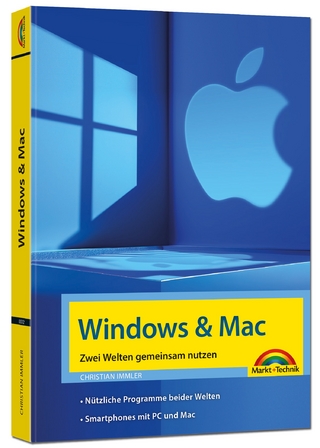
Cocoa® Programming for Mac® OS X
Addison Wesley (Verlag)
978-0-201-72683-1 (ISBN)
- Titel erscheint in neuer Auflage
- Artikel merken
Apple's Cocoa framework and tools are indispensable to every developer who wants to take full advantage of Mac OS X's features and performance, and get applications to market rapidly. However, Cocoa has a steep learning curve, and the official documentation leaves much to be desired. Now, Cocoa insider Aaron Hillegass presents the first start-to-finish guide for serious Cocoa development. In this book, Hillegass leverages his experience as the creator of the world's first independent Cocoa training course, anticipating the questions that real-world developers ask about Cocoa -- and offering deep insight into the design patterns that give Cocoa its extraordinary power and elegance. He begins with an overview of Cocoa's goals, capabilities, and toolset. Learn how to use Cocoa's Project Builder to track all of your application's diverse resources, edit code, and compile and run applications. Master the Cocoa Interface Builder: leverage the full capabilities of Mac OS X's breakthrough Aqua interface, then go beyond "windows and widgets" to create classes and edit their attributes.Hillegass gives experienced C and object-oriented developers all the skills they need to use Objective-C, the preferred language for Cocoa development.
Coverage includes: custom views; responders and keyboard events; fonts and NSString; pasteboards; categories; compilation with the GNU C (gcc) compiler; debugging with the GNU debugger (gdb); and much more. The book includes extensive code examples; most in Objective-C, some in Java.
Aaron Hillegass, who worked at NeXT and Apple, now teaches popular Cocoa programming classes at Big Nerd Ranch. At NeXT, he wrote the first course on OpenStep, the predecessor to today's Cocoa tools.This book is based on the Big Nerd Ranch course and is influenced by more than a decade of work with OpenStep and Cocoa.
Acknowledgments.
1. Cocoa: What Is It?
A Little History.
Tools.
Objects, Classes, Methods, and Messages.
Frameworks.
How to Read this Book.
Typographical Conventions.
How to Learn.
2. Let's Get Started.
In Project Builder.
In Interface Builder.
Back in Project Builder.
Documentation.
What Have You Done?
3. Objective-C.
Creating and Using Instances.
Using Existing Classes.
Creating Your Own Classes.
The Debugger.
What Have You Done?
For the More Curious: How Does Messaging Work?
Challenge.
4. Controls.
Some Commonly Used Subclasses of NSControl.
Start the RaiseMan Example.
The Interface File for MyDocument.
Layout the Interface.
Implementing the Person Class.
Implementing the MyDocument Class.
What Have You Done?
For the More Curious: Setting the Target Programmatically.
Challenge.
5. Helper Objects.
NSTableView and Its Data Source.
MyDocument Interface File.
Layout the User Interface.
Make Connections.
Edit MyDocument.m.
Key-value Coding.
Delegates.
For the More Curious: How Delegates Work.
Challenge 1.
Challenge 2.
6. Archiving.
NSCoder and NSCoding.
The Document Architecture.
Saving and NSArchiver.
Loading and NSUnarchiver.
Informing the Document That It Has Been Edited.
Setting the Extension and Icon for the File Type.
For the More Curious: Preventing Infinite Loops.
For the More Curious: Versioning.
For the More Curious: Creating a Protocol.
7. Nib Files and NSWindowController.
NSPanel.
Adding a Panel to the Application.
For the More Curious: NSBundle.
Challenge 1.
Challenge 2.
8. User Defaults.
NSDictionary and NSMutableDictionary.
NSUserDefaults.
Creating Keys for the Names of the Defaults.
Registering Defaults.
Let the User Edit the Defaults.
Using the Defaults.
Saving the Frame of a Window.
For the More Curious: Reading and Writing Defaults from the Command-line.
Challenge.
9. Using Notifications.
What Notifications Are.
What Notifications Are Not.
NSNotification.
NSNotificationCenter.
Posting a Notification.
Registering as an Observer.
Unregistering the Observer.
Handling the Notification When It Arrives.
For the More Curious: Delegates and Notifications.
For the More Curious: The userInfo Dictionary.
Challenge.
10. Using Alert Panels.
Make the User Confirm the Delete.
Challenge.
11. Localization.
Localizing a Nib File.
String Tables.
For the More Curious: nibtool.
Challenge.
12. Custom Views.
The View Hierarchy.
Get a View to Draw Itself.
Drawing with NSBezierPath.
NSScrollView.
For the More Curious: Cells.
Challenge 1.
13. Images and Mouse Events.
NSResponder.
NSEvent.
Getting Mouse Events.
Using NSOpenPanel.
Composite an Image Onto Your View.
The View's Coordinate System.
Autoscrolling.
For the More Curious: NSImage.
Challenge.
14. Responders and Keyboard Events.
NSResponder.
NSEvent.
Create a New Project with a Custom View.
15. Working with Fonts and NSString.
NSFont.
NSAttributedString.
Drawing Strings and Attributed Strings.
Making Letters Appear.
Getting Your View to Generate PDF Data.
For the More Curious: NSFontManager.
Challenge 1.
Challenge 2.
16. Pasteboards and Nil-targeted actions.
NSPasteboard.
Add Cut, Copy, and Paste to BigLetterView.
Nil-targeted Actions.
For the More Curious: Which Object Really Sends the Action Message?
For the More Curious: Lazy Copying.
Challenge.
17. Categories.
Add a Method to NSString.
18. Drag and Drop.
Make BigLetterView a Drag Source.
Make a BigLetterView a Drag Destination.
Challenge.
19. NSTimer.
Layout the Interface.
Make Connections.
Adding Code to AppController.
Challenge.
20. Sheets.
Adding a Sheet.
For the More Curious: contextInfo.
For the More Curious: NSDrawer.
Challenge.
21. Creating NSFormatters.
A Basic Formatter.
The Delegate of the NSControl.
Checking Partial Strings.
The Control's Delegate and Partial Strings.
Formatters that Return Attributed Strings.
Challenge.
22. Printing.
Adding Printing to TypingTutor.
Dealing with Pagination.
Challenge.
23. Updating Menu_n.
Making a BigLetterView Uncopyable.
24. Working with NSTextView.
NSTextView.
Messages the Delegate Will Be Sent.
Build the Editor With Which This Book Was Written.
For the More Curious: The Field Editor.
25. Using Java with Cocoa.
Don't Use Java to Write Cocoa Applications.
If You Must Use Java to Write Cocoa Applications.
26. Creating Interface Builder Palettes.
Add NSCoding Methods to BigLetterView.
Create a Palette Project.
Edit the Nib File for Your Palette.
palette.table.
Build and Test.
FinishInstantiate.
Adding an Inspector.
For the More Curious: How to Palettize Objects That Are Not Views.
Challenge.
27. The End.
Index. 0201726831T10152001
| Erscheint lt. Verlag | 12.12.2001 |
|---|---|
| Verlagsort | Boston |
| Sprache | englisch |
| Maße | 186 x 235 mm |
| Gewicht | 840 g |
| Themenwelt | Informatik ► Betriebssysteme / Server ► Macintosh / Mac OS X |
| ISBN-10 | 0-201-72683-1 / 0201726831 |
| ISBN-13 | 978-0-201-72683-1 / 9780201726831 |
| Zustand | Neuware |
| Informationen gemäß Produktsicherheitsverordnung (GPSR) | |
| Haben Sie eine Frage zum Produkt? |
aus dem Bereich



